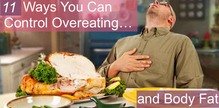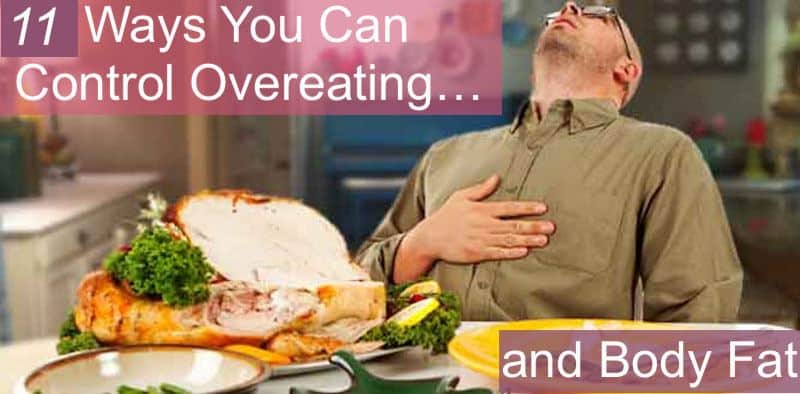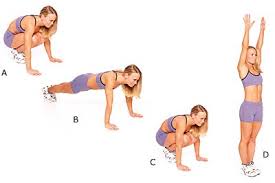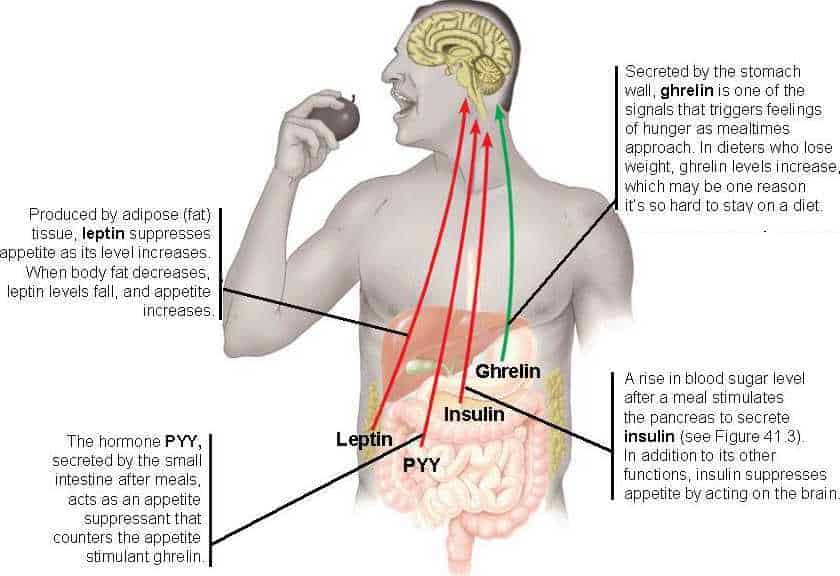11 Ways You Can Control Overeating and Body Fat

You can control overeating during the holidays and throughout the year — as well as the damage it does to your body — by managing your insulin/glucose response to food. Here’s how to do it.

WE TEND to think that it’s only during the Holidays that we grapple with gluttony, but really those mega meals are too available too much of the time, which begs the question:
“How can you control overeating throughout the year”?
Glad you asked.
Here’s what we’re going to cover:
- How insulin/blood sugar regulation is the key to preventing the inevitable weight gain that results from eating too much too often.
- What helps regulate blood sugar, such as acetic acid, supplements and activating muscle fiber.
- How drinking green tea helps reduce blood sugar spikes.
Let’s dig in…
What You Need To Know About Insulin and Acetic Acid
Before we get to the list of 11 interventions that can help you control overeating and the damage it does, it would be helpful to understand a bit about:
- Insulin, and
- Acetic acid.
We want to cut the amount of insulin produced by the body to deal with the increase in blood sugar resulting from food and drink consumption. And we want to slow down the digestive process and blood sugar spike via the acetic acid contained in apple cider vinegar.
The Insulin Bottom Line: Less Carbs Means Less Body Fat
The British Medical Journal recently published what is destined to become a landmark paper in the field of macro nutrients. Rather than focusing on calories, the study called Effects of a low carbohydrate diet on energy expenditure during weight loss maintenance examines the effect of insulin on body composition and energy output.
The study’s basic conclusion:
Low-carb diets are probably the best for those seeking to lose body fat.
The study is part of a larger case that Dr. David Ludwig (one of the researchers) has developed that says the real drivers behind obesity in America are refined grains, potato products, and sugars — not high-fat foods. This is based on a hypothesis called the carbohydrate-insulin model, which he describes in his book, many op-eds, and several scientific papers that describe how carbohydrate-dominate diets lead to weight gain for many people. (1)
Dr. Ludwig’s study indicates that eating carbohydrate-rich meals leads to the overproduction of insulin. And the overproduction of insulin makes us fat.
Insulin is a hormone made by the pancreas that allows your body to use sugar (glucose) from carbohydrates (primarily) in the food that you eat for energy or to store glucose for future use. Insulin helps keeps your blood sugar level from getting too high (hyperglycemia) or too low (hypoglycemia).
And where do you think that extra glucose gets stored?
Yep, into fat cells.
When you eat more carbs that makes more glucose than you need to meet your body’s energy requirements, or that can be stored in your brain, liver and muscles, the glucose gets shuttled by insulin into your fat cells. Dr. Ludwig’s work suggests that high-carb diets cause these cells to essentially hoard glucose and cut the amount of a different hormone, called glucagon, which helps our body use up the glucose, leaving the body without an energy source. He believes that this creates a vicious cycle: We feel more hungry and therefore consume more to fill this void.
It makes sense that sugary, quickly digested carbs, such as those found in snack foods, deserts and processed grains should be avoided most of the time, and when consumed, eaten with a quality, high-fat food to slow down the blood sugar spike.
A Note About Keto:
The Acetic Acid Bottom Line: Consume Apple Cider Vinegar Often
I don’t subscribe to the apple cider miracle cure hypothesis, but the science on it suggests that apple cider can help to control sugar/glucose spikes and increase satiety (get fuller with less food). (2)
The acetic acid in apple cider vinegar slow down the digestive process because it deactivates the production of certain digestive enzymes responsible for carbohydrate digestion. This makes it more difficult for the body to breakdown carbohydrates when eaten along with vinegar. The vinegar forces the body to release the simple sugars from those carbohydrates slowly into the bloodstream preventing blood sugar spikes.
Vinegar supplementation lowers glucose and insulin responses and increases satiety after a bread meal in healthy subjects is the name of an interesting study that shows the effects of acetic acid on insulin, glucose and satiety.
In the study, volunteers ate white bread. You can’t choose anything better than white bread to test the reaction of insulin and glucose, except perhaps unadulterated table sugar.
The study demonstrated how vinegar reduced the postprandial (after meal) responses of blood glucose and insulin, and increased the subjective rating of satiety: “Enough bread already, I’m full!”.
The researchers concluded that:
There was an inverse dose-response relation between the level of acetic acid and glucose and insulin responses and a linear dose-response relation between acetic acid and satiety rating. (3)
Translation:
The more vinegar consumed, the less glucose and insulin and the higher satiety reported.
Now that you have an appreciation of the insulin/carbs dance and the effect of apple cider vinegar on carb digestion and satiety, let’s knock down that list of 11 ways you can control overeating and body fat.
11 Ways You Can Control Overeating and Body Fat
The focus of these 11 interventions is to make it more difficult for carbs to spike blood sugar, to become digested, and to allow you get fuller with fewer carbs and calories. The more “complicated” the carbohydrates are to digest, the slower the release of sugar into your bloodstream.
1.5 Hours Before Meal
(1) Drink a smoothie
The idea here to control overeating is to make sure that you don’t arrive at your big meal famished. Rather than do that, eat something that’s good for you and will “take the edge off”.
Make sure the smoothie made of quality protein powder, such as hemp, pea, rice and/or sprouted grain powders (not whey, because it spikes blood sugar which is fine post workout, but not now.), fiber (hemp, chia and/or flax seeds), green stuff such as spinach, kale or broccoli.
1 Hour Before Meal
(2) Drink a fiber drink
Pour eight-plus ounces of pure water in a shaker jar, add a level tablespoon of psyllium seed powder, shake and guzzle.
1/2 Hour Before Meal
(3) Ingest supplements that increase insulin sensitivity
Lifestyle guru, et al, Tim Ferriss recommends “PAGG” to control overeating, which consists of the following four supplements, along with the amounts of each he uses per serving:
- Policosanol, 20 – 25 mg
- Alpha-lipoic acid, 100 – 300 mg
- Green tea flavanols, 325 mg
- Garlic extract, 200 mg
Amazon.com offers this bundle, called PAGG Stack Supplement System.
20 Minutes Before Meal
(4) Drink Water + Apple Cider Vinegar
Eight ounces of pure water will do to help control overeating, but more is better. Water will help fill up your stomach and cut hunger. Add one tablespoon of Apple Cider Vinegar to the water.
5 Minutes Before Meal
(5) Briefly exercise large muscles
Working your large muscles, even briefly, brings glucose transporter type 4 (“GLUT-4”) to the surface of muscle cells.
OK, so what?
The major cellular mechanism that diminishes blood glucose when carbohydrates are ingested is the transport of insulin-stimulated glucose transport into muscle. The principal glucose transporter protein that does this is GLUT4, which plays a key role in regulating whole body glucose homeostasis. (4)
Once you stop cringing from that description, just remember that by working your large muscles before eating, there’s someplace for the glucose in your bloodstream to go — like to fuel contracting muscles — rather than building up your midsection’s muffin top.
Given the size of your leg muscles, squats are best. Do 60 to 90 seconds of squats (no weight but you). If there’s still gas left in the tank, do some push-ups (on your knees if regular ones are too hard). If there’s no one around, or you don’t mind looking foolish, try burpees.

Burpees, step by step
During The Meal
(6) Eat fat with carbs
This particularly pertains to dessert or some sugar-jammed sweet potatoes or cranberry sauce. Chew on some walnuts or almonds. Add some sour cream or full-fat (no fruit) yogurt if available. Or just plain ole butter. Adding fat will slow down the blood sugar uptake and help control overeating.
(7) Drink green tea
Sipping some green tea throughout your meal will not only slow down how quickly you eat, but also lower postprandial (post-meal) blood glucose.
In a study of 16 human participants, foods rich in polyphenols, including EGCG, a polyphenol in tea, significantly lowered post-meal blood glucose readings. Among the foods in the study was green tea. The polyphenols facilitated glucose transport through the bloodstream, preventing a buildup. (5)
(8) Eat slowly
This is my Achilles heel. I begin the meal with this intent, but before you know it, I lift my head from the plate after devouring its contents like a ravenous dog, and look up to see that my fellow diners are staring blankly at me, forks still unsullied from their first jab of food.
The slower you eat, the more time the grehlin hormone in your stomach has to signal to the hypothalamus in your brain that you’re full, which obviously will help control overeating. (6)

(9) Pause before dessert and do #5 again
Simply say, “Excuse me, I need to powder my nose”, go into another room for 30 seconds or so of big-muscle exercise. Given your burgeoning food-fed belly, you may want to forgo the burpees. Try some squats instead.
(10) Drink another glass of water
Again, you’re seeking some satiation before you plow into the most insulin-activating part of your meal, so you don’t eat as much. And surely you’ll be thirsty after all those squats (#8)
After The Meal
(11) Drink Apple Cider Vinegar (again)
Now that the meal is done, get some more Apple Cider Vinegar into your system to slow down the glucose circulating in your blood stream. Use one tablespoon per eight ounces of water.
Your Takeaway
The key to control overeating and lose body fat is to minimize the blood sugar uptake from the meal you eat.
This is done by:
- Reducing the amount of sugar that gets into your blood stream through food choice (more protein and healthy fats than sugary carbs) and food pairing (sugary carbs eaten together with healthy fats); and
- Directing where the glucose in the blood goes — away from fat cells and into muscle.
You’re unlikely to try all 11 interventions, which is fine. Any one of them you do will be better than having no game plan at all.
Happy eating!
Last Updated on February 7, 2024 by Joe Garma





